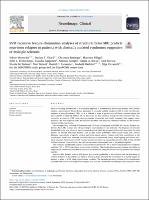| dc.contributor | Vall d'Hebron Barcelona Hospital Campus |
| dc.contributor.author | Wottschel, Viktor |
| dc.contributor.author | Enzinger, Christian |
| dc.contributor.author | Filippi, Massimo |
| dc.contributor.author | Frederiksen, Jette L. |
| dc.contributor.author | Gasperini, Claudio |
| dc.contributor.author | Rovira Cañellas, Alex |
| dc.contributor.author | Tintore Subirana, Mar |
| dc.contributor.author | Chard, Declan |
| dc.date.accessioned | 2021-04-12T08:08:27Z |
| dc.date.available | 2021-04-12T08:08:27Z |
| dc.date.issued | 2019 |
| dc.identifier.citation | Wottschel V, Chard DT, Enzinger C, Filippi M, Frederiksen JL, Gasperini C, et al. SVM recursive feature elimination analyses of structural brain MRI predicts near-term relapses in patients with clinically isolated syndromes suggestive of multiple sclerosis. NeuroImage Clin. 2019 Jan 1;24. |
| dc.identifier.issn | 2213-1582 |
| dc.identifier.uri | https://hdl.handle.net/11351/5838 |
| dc.description | Multiple sclerosis; Machine learning classification; Feature selection |
| dc.description.abstract | Machine learning classification is an attractive approach to automatically differentiate patients from healthy subjects, and to predict future disease outcomes. A clinically isolated syndrome (CIS) is often the first presentation of multiple sclerosis (MS), but it is difficult at onset to predict who will have a second relapse and hence convert to clinically definite MS. In this study, we thus aimed to distinguish CIS converters from non-converters at onset of a CIS, using recursive feature elimination and weight averaging with support vector machines. We also sought to assess the influence of cohort size and cross-validation methods on the accuracy estimate of the classification.
We retrospectively collected 400 patients with CIS from six European MAGNIMS MS centres. Patients underwent brain MRI at onset of a CIS according to local standard-of-care protocols. The diagnosis of clinically definite MS at one-year follow-up was the standard against which the accuracy of the model was tested. For each patient, we derived MRI-based features, such as grey matter probability, white matter lesion load, cortical thickness, and volume of specific cortical and white matter regions. Features with little contribution to the classification model were removed iteratively through an interleaved sample bootstrapping and feature averaging approach. Classification of CIS outcome at one-year follow-up was performed with 2-fold, 5-fold, 10-fold and leave-one-out cross-validation for each centre cohort independently and in all patients together.
The estimated classification accuracy across centres ranged from 64.9% to 88.1% using 2-fold cross-validation and from 73% to 92.9% using leave-one-out cross-validation. The classification accuracy estimate was higher in single-centre, smaller data sets than in combinations of data sets, being the lowest when all patients were merged together.
Regional MRI features such as WM lesions, grey matter probability in the thalamus and the precuneus or cortical thickness in the cuneus and inferior temporal gyrus predicted the occurrence of a second relapse in patients at onset of a CIS using support vector machines. The increased accuracy estimate of the classification achieved with smaller and single-centre samples may indicate a model bias (overfitting) when data points were limited, but also more homogeneous. We provide an overview of classifier performance from a range of cross-validation schemes to give insight into the variability across schemes. The proposed recursive feature elimination approach with weight averaging can be used both in single- and multi-centre data sets in order to bridge the gap between group-level comparisons and making predictions for individual patients. |
| dc.language.iso | eng |
| dc.publisher | Elsevier |
| dc.relation.ispartofseries | NeuroImage: Clinical;24 |
| dc.rights | Attribution-NonCommercial-NoDerivatives 4.0 International |
| dc.rights.uri | http://creativecommons.org/licenses/by-nc-nd/4.0/ |
| dc.source | Scientia |
| dc.subject | Esclerosi múltiple |
| dc.subject | Imatgeria per ressonància magnètica |
| dc.subject.mesh | Multiple Sclerosis |
| dc.subject.mesh | Magnetic Resonance Imaging |
| dc.subject.mesh | Support Vector Machine |
| dc.title | SVM recursive feature elimination analyses of structural brain MRI predicts near-term relapses in patients with clinically isolated syndromes suggestive of multiple sclerosis |
| dc.type | info:eu-repo/semantics/article |
| dc.identifier.doi | 10.1016/j.nicl.2019.102011 |
| dc.subject.decs | esclerosis múltiple |
| dc.subject.decs | imagen por resonancia magnética |
| dc.subject.decs | máquina de soporte vectorial |
| dc.relation.publishversion | https://doi.org/10.1016/j.nicl.2019.102011 |
| dc.type.version | info:eu-repo/semantics/publishedVersion |
| dc.audience | Professionals |
| dc.contributor.organismes | Institut Català de la Salut |
| dc.contributor.authoraffiliation | [Wottschel V] Department of Radiology and Nuclear Medicine, Amsterdam University Medical Centers, Location VUmc, Amsterdam, The Netherlands. Queen Square MS Centre, University College London, London, United Kingdom. [Chard DT] Queen Square MS Centre, University College London, London, United Kingdom. National Institute of Health Research (NIHR), University College London Hospitals, Biomedical Research Centre, London, United Kingdom. [Enzinger C] Research Unit for Neuronal Repair and Plasticity, Department of Neurology, Medical University of Graz, Graz, Austria. [Filippi M] Neuroimaging Research Unit, Institute of Experimental Neurology, Division of Neuroscience, San Raffaele Scientific Institute, Vita-Salute San Raffaele University, Milan, Italy. [Frederiksen JL] Rigshospitalet-Glostrup and University of Copenhagen, Copenhagen, Denmark. [Gasperini C] San Camillo-Forlanini Hospital, Rome, Italy. [Rovira A, Tintoré M] Vall d'Hebron Hospital Universitari, Barcelona, Spain |
| dc.identifier.pmid | 31734524 |
| dc.identifier.wos | 000504663800125 |
| dc.relation.projectid | info:eu-repo/grantAgreement/EC/H2020/EU.3.1.1. |
| dc.rights.accessrights | info:eu-repo/semantics/openAccess |

